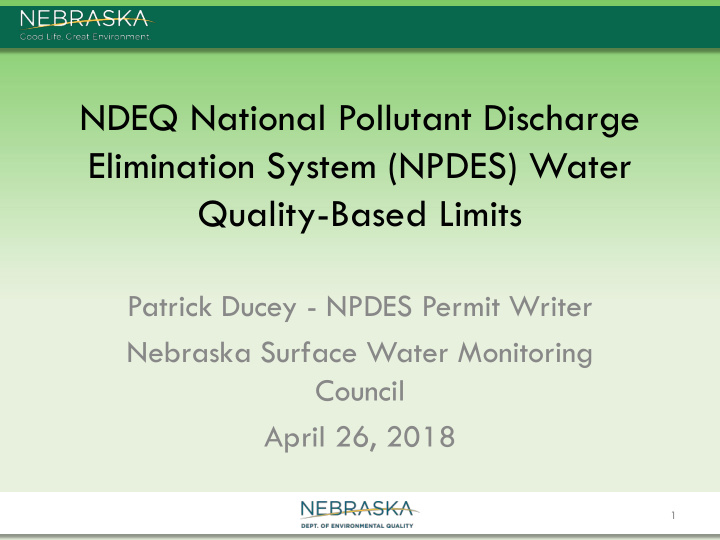



NDEQ National Pollutant Discharge Elimination System (NPDES) Water Quality-Based Limits Patrick Ducey - NPDES Permit Writer Nebraska Surface Water Monitoring Council April 26, 2018 1
NPDES and NPP Permits Making what is illegal, legal 2
NDEQ Wastewater Permitting • Federal Water Pollution Control Act (FWPCA), Clean Water Act (1977) • National Pollutant Discharge Elimination System (NPDES) – 1972 Amendment to FWPCA • Nebraska Pretreatment Program (NPP) – one of four states with a program • Concentrated Animal Feeding Operations (CAFOs) – not covered in this presentation 3
NPDES Point Sources and Non-Point Sources of Pollution • Point source – publicly owned treatment works (POTWs), PWTPs, industrial discharges (process and non-process wastewater), MS4s, CSOs, construction stormwater, industrial stormwater, fish hatcheries • Non-point sources – Agricultural wastewater, silvicultural discharges 4
Permit Limits • Effluent limitation guidelines (ELGs) or technology-based effluent limitations (TBELs) • Water quality-based effluent limitations (WQBELs) • NPDES permits authorize discharges to waters of the state 5
Technology-Based Effluent Limits • Limits based on level of treatment technology • Used for: - POTWs (BOD, TSS) - ELGs for industrial process wastewater - NPP permitted facilities and limits • BPT, BCT, BAT, new source, existing source • Best professional judgment process (BPJ) for non- promulgated limits 6
Water Quality-Based Effluent Limits 7
Water Quality-Based Effluent Limits • Site-specific, pollutant specific • Limits are developed using effluent parameters, receiving stream parameters, and water quality criteria • NPDES criteria set forth in NDEQ Title 117, Chapter 4 • Common permit parameters with WQBELS: ammonia, total residual chlorine (TRC), chloride, conductivity, dissolved metals, whole effluent toxicity (WET) • Limits are developed in wasteload allocations (WLAs) 8
Example WLA - Ammonia • Ammonia is a non-conventional pollutant limited in all POTW NPDES permits and some industrial permits • Ammonia is toxic to freshwater mussels • NDEQ uses two methodologies to develop limits: steady-state and CORMIX • First example will be steady-state • Calculations are derived for Nebraska from the methods set forth in the Technical Support Document For Water Quality-based Toxics Control (EPA 505/2-90- 001, March 1991) 9
New Ammonia Criteria is Protective of Mussels Criteria is based on pH and temperature 10
WQBEL Modeling Data Required for Calculating Steady-State Limits for Ammonia • Effluent Parameters • Receiving Stream – Median Flow – Flow (1Q10, 30Q5) – Critical temperature – Median temperature – Critical pH – Median pH – Coefficient of variation – Median and critical background ammonia – Stream characteristics Critical: 90 th percentile of data 11
Effluent Data – EPA ICIS System Obtained from Facility Discharge Monitoring Reports (DMRs) 12
Receiving Stream Data – NDEQ Ambient Monitoring Stations, USGS, DNR 13
Criteria and Mixing Zones • Ammonia and other wasteload allocations are derived using Acute and Chronic criteria • Effluent must meet criteria at the end of a mixing zone • Coldwater and Warmwater ammonia criteria and mixing zones 14
Calculation of Limits Input parameters: effluent flow, criteria, receiving stream characteristics, CV “MATH” Wasteload Allocation Limits 15
“MATH” to Produce Limits 16
NDEQ Steady State Wasteload Allocation 17
Wasteload Allocation Results and Proposed Limits 18
CORMIX Method 19
Data Needed 20
CORMIX • Useful for discharges into larger streams and rivers • Most accurate results as more model parameters are used in the calculation (pipe diameter, different season characteristics, water density, decay coefficient) • Can be used to find background pollutant levels • Can model diffusers and different pipe orientations 21
CORMIX Use Example 22
Model Proposed Results in the Permit • Steady-state or CORMIX WLA results Geneva WWTF – Projected Ammonia Limitations Derived from WLAs Parameter Monthly Average Maximum Spring Ammonia 2.96 mg/L 5.93 mg/L (March 1 – May 31) 1.90 kg/day 3.82 kg/day Summer Ammonia 1.48 mg/L 2.96 mg/L (June 1 – October 31) 0.94 kg/day 1.88 kg/day Winter Ammonia 3.23 mg/L 6.47 mg/L (Nov. 1 – February 28 [29]) 2.11 kg/day 4.24 kg/day • Existing limits Spring Ammonia 6.21 mg/L 10.76 mg/L Monthly Summer Ammonia 3.55 mg/L 6.15 mg/L Monthly Winter Ammonia 2.98 mg/L 5.17 mg/L Monthly • Use most stringent seasonal limits, compare to existing 23
Final Permit Limits 24
Other Pollutant Parameters and Models • Dissolved metals – hardness-based criteria • TRC – no background chlorine • Conductivity – only agricultural season • Dissolved oxygen – for BOD and CBOD, using Streeter- Phelps, assumes instant and complete mixing • Reasonable potential calculation – does the pollutant have the RP to violate water quality standards 25
Antidegradation • All permit limits and requirements written and enforced to maintain water quality and to be protective of the fishable/swimmable goals of the CWA 26
Questions? Patrick Ducey – (402) 471-2188 Ppatrick.ducey@nebraska.gov 27
Recommend
More recommend